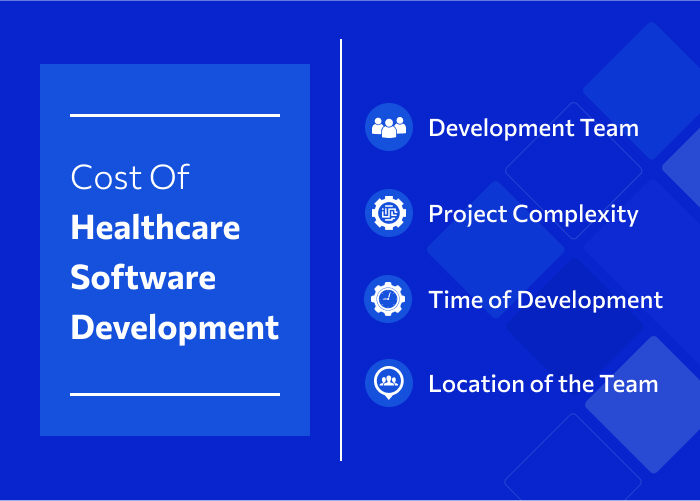Cost of Healthcare software development

The cost of developing healthcare software differs widely based on the time, complexity, location of the development company, and more. Let’s discuss this in detail.
- Development Team: The size and skill of the crew also influence the development cost. Keep in mind that every little factor, including the number of workers, their qualifications and experience, and the software developers’ technical stack entailed in the project, may have an impact on the project’s ultimate cost.
- Project Complexity: The kind of software or medical website you wish to create will determine how much your project will cost. The final budget will depend heavily on factors like the complexity of the design and the quantity of features you wish to incorporate.
- Time of Development: Furthermore, in healthcare software development, the difficulty of software development is closely related to time. Your healthcare project will become more time-consuming and expensive in proportion to the complexity of your program.
- Location of the Team: If you hire a team from the USA, the cost of healthcare software development would be higher compared to a team from India. The hourly pay of developers from India ranges from $25 to $99 while you can expect to pay $99 to $150 or more to developers from the USA.
Process of developing Healthcare software
- Requirement Gathering: Recognize the goals and requirements for the medical software. For the purpose of identifying features, functionality, and regulatory requirements, discussions with administrators, end users, and healthcare experts are conducted.
- Planning and Design: Make a thorough strategy that includes the databases, user interface design, workflows, technologies to be used, and architecture of the product. In order to visualize the features and layout of the software, wireframes or mockups are also created during this phase.
- Development: This includes creating user interfaces on the front end and server-side logic on the back end, designing and implementing databases, integrating them with other systems, and putting security measures in place.
- Testing: Make sure the program is thoroughly tested to make sure it satisfies user needs, runs well, and is free of errors and vulnerabilities. User acceptability testing, system testing, integration testing, and unit testing are all included in this. During this stage, adherence to healthcare laws like HIPAA may also be examined.
- Regulatory Compliance: Verify that the program conforms with all applicable norms and regulations for healthcare. Acquiring certifications or going through audits could be necessary to prove adherence to laws like HIPAA, GDPR, or FDA requirements pertaining to medical devices.
- Deployment: Distribute the software to the designated users or medical institutions. Installation, configuration, and administrator and end-user training may be required for this.
- Maintenance and Support: Maintain and support the program continuously, making bug fixes, upgrades, and additions available. This guarantees that despite evolving healthcare demands and legal regulations, the software will continue to be secure, functional, and up-to-date.
Conclusion
Creating software for the healthcare industry necessitates a thorough strategy that combines technological know-how with a thorough comprehension of user requirements, procedures, and laws.
Healthcare software may boost overall organizational efficiency, expedite administrative procedures, and improve patient care via meticulous design, rigorous development, and testing.
In order to protect patient privacy and safety, compliance with legal requirements such as HIPAA, GDPR, and FDA regulations is essential. The program must get ongoing support and maintenance in order to remain secure, functioning, and compliant with changing legal and healthcare regulations.
Healthcare software developers may develop solutions that significantly affect the caliber and provision of healthcare services by adhering to best practices and encouraging cooperation among stakeholders.
FAQs
What are some common challenges in healthcare software development?
How do you ensure patient data privacy and security in healthcare software?
What technologies are commonly used in healthcare software development?
How do you handle regulatory compliance in healthcare software development?
What are the key considerations when designing user interfaces for healthcare software?
Ravi Bhojani is the Chief Marketing Officer (CMO) at Alian Software, where he spearheads the company’s marketing strategies and drives its brand presence in the competitive IT services landscape. With over a decade of experience in the technology and marketing sectors, Ravi has consistently demonstrated his ability to blend innovative marketing techniques with deep industry knowledge to deliver outstanding results.